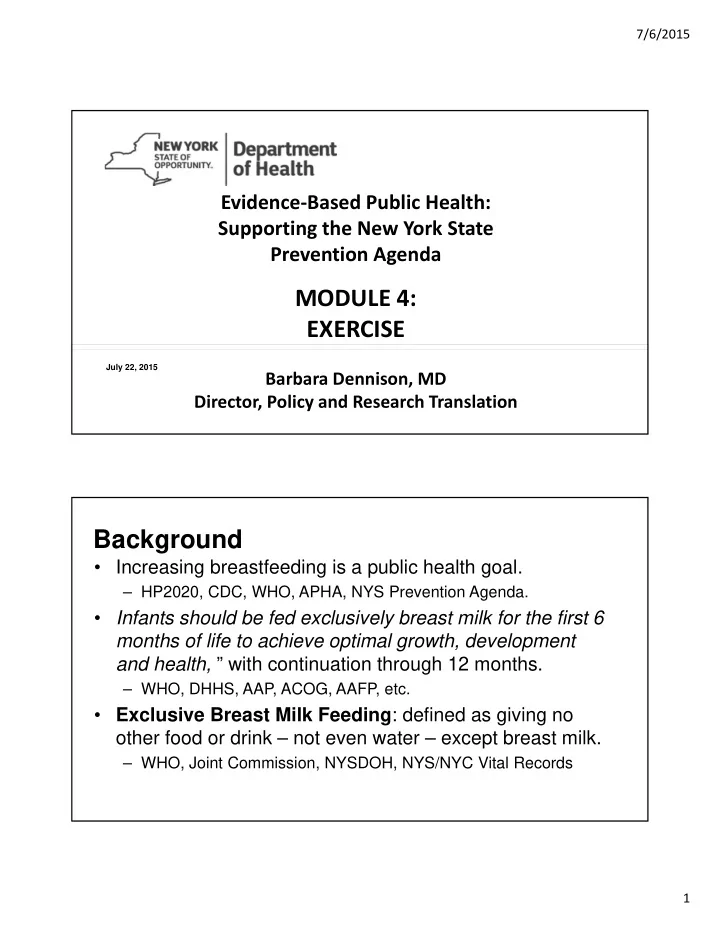

7/6/2015 Evidence ‐ Based Public Health: Supporting the New York State Prevention Agenda MODULE 4: EXERCISE July 22, 2015 Barbara Dennison, MD Director, Policy and Research Translation Background • Increasing breastfeeding is a public health goal. – HP2020, CDC, WHO, APHA, NYS Prevention Agenda. • Infants should be fed exclusively breast milk for the first 6 months of life to achieve optimal growth, development and health, ” with continuation through 12 months. – WHO, DHHS, AAP, ACOG, AAFP, etc. • Exclusive Breast Milk Feeding : defined as giving no other food or drink – not even water – except breast milk. – WHO, Joint Commission, NYSDOH, NYS/NYC Vital Records 1
7/6/2015 Breastfeeding Provides Health Benefits to Infants Short Term Benefits • 72% Reduction in hospitalization from lower respiratory diseases in the first year of life • 64% Fewer episodes of gastroenteritis • 50% Reduction in otitis media Source: US Department of Health and Human Services. The Surgeon General’s Call to Action to Support Breastfeeding, Washington, DC; 2011. 3 Long-Term Benefits of Breastfeeding to Children • Lower total cholesterol levels • Lower systolic and diastolic blood pressure • Lower risk of type-2 diabetes • Higher scores on intelligence tests World Health Organization, Long-Term Effects of Breastfeeding, Systematic Review, 2013 4 2
7/6/2015 Breastfeeding Provides Health Benefits to Women Short Term Benefits • Reduction in postpartum bleeding, anemia • Faster return to pre-pregnancy weight • Reduced risk of excess maternal weight gain Long Term Benefits • Reduced risk of breast cancer • Reduced risk of ovarian cancer Source: US Department of Health and Human Services. The Surgeon General’s Call to Action 5 to Support Breastfeeding, Washington, DC; 2011 . Breastfeeding Metrics - HP 2020 vs. NYS 2013 100 85.0 90 81.9 HP 2020 80 NYS 70.0 70 Percent 60 Source: NYSDOH, 51.0* 50 Birth Certificate, 41.7 2013 40 30 14.2 20 10 0 Any BF Exclusive BF BF Supplemented *CDC Breastfeeding Report Card 2014: NIS shows that NYS has the highest % of breastfed infants receiving formula before 2 days of age in the U.S. 3
7/6/2015 Exclusive Breastfeeding Maternal Education, stratified by Race/Ethnicity, 2011 100% < High School 90% High School graduate or 80% GED 70% 59.0% 60% 55.8% 52.8% 52.0% 47.4% 50% 43.8% 40.0% 37.8% 40% 35.8% 34.6% 33.6% 32.0% 28.4% 27.0% 30% 24.4% 22.9% 21.7% 17.9% 17.7% 20% 13.4% 10% 0% White, non ‐ Black, non ‐ Asian/PI, non ‐ Am Indian, Hispanic Hispanic Hispanic Hispanic non ‐ Hispanic Race/ethnicity Exclusive Breastfeeding by Maternal Education, stratified by Race/ethnicity and, 2011 100% White, nH 90% Black, nH Asian/PI, nH 80% Am Indian, nH 70% Hispanic 60% 59.0% 55.8% 52.8% 52.0% 50% 47.4% 43.8% 40% 40.0% 37.80% 35.8% 34.6% 33.6% 32.00% 30% 28.4% 27.00% 24.4% 22.90% 21.7% 20% 17.7% 17.9% 13.4% 10% 0% < High School HS grad/GED Some college College degree 4
7/6/2015 Exercise Small Groups with 5-6 Each A problem described by NY State Senator Nestle Form groups to work in teams Discuss and write-down, following worksheet guidance Background/epidemiologic issue Programmatic questions (intervention, evaluation, managerial, policy) Avoid getting caught up in solutions and outcomes at this point 5
Recommend
More recommend